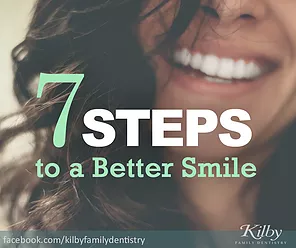7 Steps to a Better Smile!
- Dr. Dustin Kilby, D.M.D. January 8, 2018
“Nothing you wear is more important than your smile.” -Connie Stevens
It's probably no surprise that a bright, white smile can make you appear younger and more attractive. In fact, according to the American Academy of Cosmetic Dentistry, a whopping 96 percent of respondents surveyed believe an attractive smile makes a person more appealing.
-
-
-
Brush Regularly
Brushing is the cornerstone of dental hygiene. It removes food particles that bacteria feed on, cleans teeth, and freshens your breath. A toothpaste with fluoride helps strengthen teeth, but you must brush for at least two minutes to allow it to do its work. As we discussed last week’s article, many electric toothbrushes have a built-in two-minute timer, which can make brushing for the full amount of time easier.
-
Floss Daily
Flossing removes the bacteria from in between your teeth that your toothbrush does not reach, which helps prevent gum disease. I recommend flossing twice a day, but if you only do it once daily, be sure to floss before bedtime. When you sleep, you produce less saliva, which leaves teeth and gums particularly vulnerable to bacteria.
-
Visit Your Dentist
Visit your dentist at least twice a year for thorough dental cleaning and an exam. Your dentist can spot the early signs of gum disease, which is more easily treated when caught in the beginning stages. If you are prone to gum disease and cavities, consider visiting your dentist every four months.
Similarly, if you have other health conditions that put you at higher risk for dental problems (such as diabetes, or a depressed immune system from HIV, cancer, or chemotherapy), ask your dentist how often you should have an exam. A special dental-hygiene regimen should be considered for pregnant women, people with diabetes, and anyone undergoing chemotherapy treatment or using medications that can affect the gums or dry out the mouth.
It's wise to examine your own mouth regularly for signs of trouble, such as a non-healing sore on the lip or inside of your cheek, swollen gums, or sensitive or bleeding gums. If you notice any of these conditions, make an dental appointment as soon as possible to have them checked out.
-
-
-
Eat Healthy
Include plenty of dairy and other calcium-rich foods in your diet. Calcium helps maintain strong bones and teeth, and the vitamin C in citrus fruits boosts gum health.
Equally important to what you do eat is what you don't. Sugary and sticky foods that stick to the crevices of your teeth are particularly bad, as bacteria feed off the sugars and release acids that cause cavities. If you do eat candy or other sweets, try to brush immediately afterward or, if that's not possible, rinse your mouth with water.
-
Don't Smoke or Use Smokeless Tobacco
People who smoke are four times more likely than nonsmokers to have gum disease, according to a study by the Journal of Periodontology. Using smokeless tobacco increases a person's risk for oral cancers, including lip, tongue, cheeks, and gums. On a smaller scale, tobacco products contribute to bad breath, also known as halitosis.
-
Whiten Teeth
While the benefits are solely cosmetic, with today's products, whitening is a very safe procedure that will not harm your teeth as long as the products are used as directed and you are under the care of a dentist. Over-the-counter whitening products are effective for minor staining; professional-strength whitening products are better for more-severe yellowing. Speak to your dentist before undergoing any whitening procedure to make sure your teeth and gums are healthy.
-
Consider Cosmetic Procedures
One of the first things a person sees when they meet you is your smile, and having crooked, stained, or missing teeth can affect your confidence. There have been great advances in cosmetic dentistry over the past decade, and it is possible to fix most cosmetic problems. Veneers for improving the appearance of crooked, stained, or oddly shaped teeth and orthodontics for straightening teeth are only two of the many cosmetic procedures offered.
However, most cosmetic dentistry is not covered by insurance, and it can be costly. It's important to schedule a consultation with an experienced cosmetic dentist prior to undergoing any type of procedure.
Good dental health goes beyond the way you look. The mouth is the gateway to the body, which means the state of your teeth and gums affects your overall health. By following these steps to a better smile, you’ll be taking important strides for the rest of your body, too.
Consider making an appointment with our office to talk about making your smile the best it can be. Contact us today!
